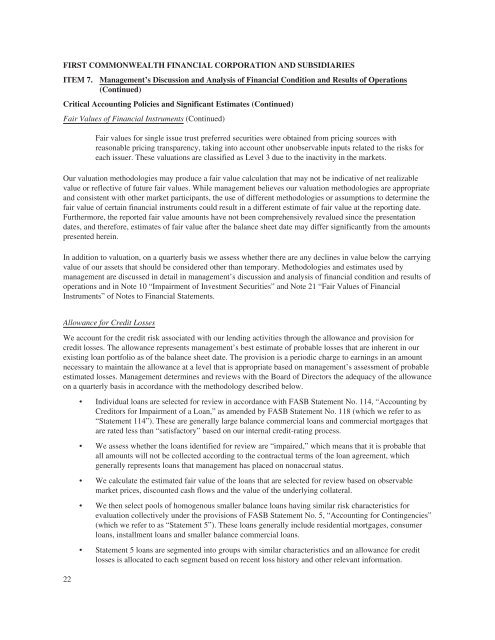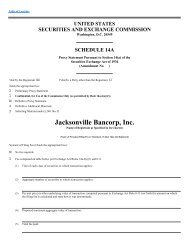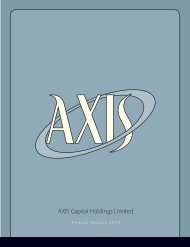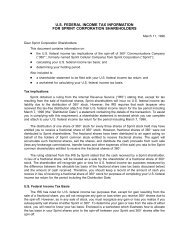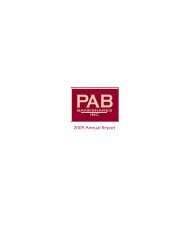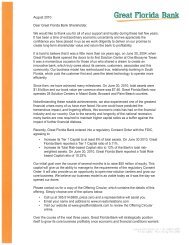Strength and Stability - SNL Financial
Strength and Stability - SNL Financial
Strength and Stability - SNL Financial
You also want an ePaper? Increase the reach of your titles
YUMPU automatically turns print PDFs into web optimized ePapers that Google loves.
FIRST COMMONWEALTH FINANCIAL CORPORATION AND SUBSIDIARIES<br />
ITEM 7. Management’s Discussion <strong>and</strong> Analysis of <strong>Financial</strong> Condition <strong>and</strong> Results of Operations<br />
(Continued)<br />
Critical Accounting Policies <strong>and</strong> Significant Estimates (Continued)<br />
Fair Values of <strong>Financial</strong> Instruments (Continued)<br />
Fair values for single issue trust preferred securities were obtained from pricing sources with<br />
reasonable pricing transparency, taking into account other unobservable inputs related to the risks for<br />
each issuer. These valuations are classified as Level 3 due to the inactivity in the markets.<br />
Our valuation methodologies may produce a fair value calculation that may not be indicative of net realizable<br />
value or reflective of future fair values. While management believes our valuation methodologies are appropriate<br />
<strong>and</strong> consistent with other market participants, the use of different methodologies or assumptions to determine the<br />
fair value of certain financial instruments could result in a different estimate of fair value at the reporting date.<br />
Furthermore, the reported fair value amounts have not been comprehensively revalued since the presentation<br />
dates, <strong>and</strong> therefore, estimates of fair value after the balance sheet date may differ significantly from the amounts<br />
presented herein.<br />
In addition to valuation, on a quarterly basis we assess whether there are any declines in value below the carrying<br />
value of our assets that should be considered other than temporary. Methodologies <strong>and</strong> estimates used by<br />
management are discussed in detail in management’s discussion <strong>and</strong> analysis of financial condition <strong>and</strong> results of<br />
operations <strong>and</strong> in Note 10 “Impairment of Investment Securities” <strong>and</strong> Note 21 “Fair Values of <strong>Financial</strong><br />
Instruments” of Notes to <strong>Financial</strong> Statements.<br />
Allowance for Credit Losses<br />
We account for the credit risk associated with our lending activities through the allowance <strong>and</strong> provision for<br />
credit losses. The allowance represents management’s best estimate of probable losses that are inherent in our<br />
existing loan portfolio as of the balance sheet date. The provision is a periodic charge to earnings in an amount<br />
necessary to maintain the allowance at a level that is appropriate based on management’s assessment of probable<br />
estimated losses. Management determines <strong>and</strong> reviews with the Board of Directors the adequacy of the allowance<br />
on a quarterly basis in accordance with the methodology described below.<br />
22<br />
• Individual loans are selected for review in accordance with FASB Statement No. 114, “Accounting by<br />
Creditors for Impairment of a Loan,” as amended by FASB Statement No. 118 (which we refer to as<br />
“Statement 114”). These are generally large balance commercial loans <strong>and</strong> commercial mortgages that<br />
are rated less than “satisfactory” based on our internal credit-rating process.<br />
• We assess whether the loans identified for review are “impaired,” which means that it is probable that<br />
all amounts will not be collected according to the contractual terms of the loan agreement, which<br />
generally represents loans that management has placed on nonaccrual status.<br />
• We calculate the estimated fair value of the loans that are selected for review based on observable<br />
market prices, discounted cash flows <strong>and</strong> the value of the underlying collateral.<br />
• We then select pools of homogenous smaller balance loans having similar risk characteristics for<br />
evaluation collectively under the provisions of FASB Statement No. 5, “Accounting for Contingencies”<br />
(which we refer to as “Statement 5”). These loans generally include residential mortgages, consumer<br />
loans, installment loans <strong>and</strong> smaller balance commercial loans.<br />
• Statement 5 loans are segmented into groups with similar characteristics <strong>and</strong> an allowance for credit<br />
losses is allocated to each segment based on recent loss history <strong>and</strong> other relevant information.


